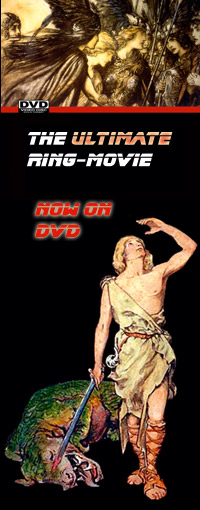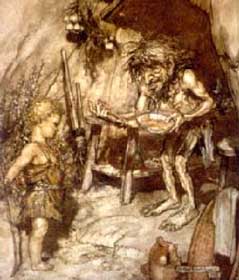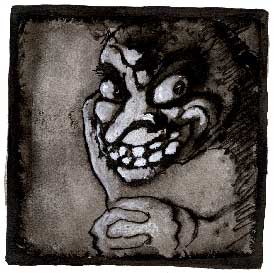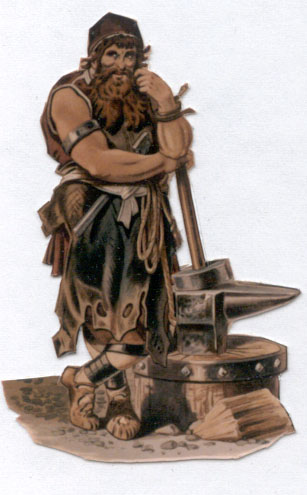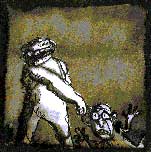![]()

![]()
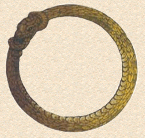
|
opera online sitemap |
||
Mime :
The harmless clown :
Mime's features are described by several motives. First of all, the rhythm of the forge ceaselessly follows him under its original shape with two rhythmic and melodic variants. The original shape describes the industrious smith. The first variant describes his lame and unsightly step, the second the shiver which seizes him when he is invaded by fear. The other motive: rumination. Mime does not stop building plans, meditating some intrigue.Mime is cunning, but his little schemes fail for lack of intelligence. Monomaniac like his brother, he lives only for his obsession: to take revenge, to conquer the Ring.
The victim of Nazism : A
new conformity wants absolutely to throw in the Wagnerian drama
the image of the Jew: Beckmesser in Meistersinger, Klingsor in Parsifal,
Alberich, Mime and Hagen in the Ring. Of the three characters, it
is Mime who was most assimilated to the Jew of the anti-semites.
One compared his vocal line to that of the songs of Synagogues and
Yiddish intonations. Besides, Wagner's regrettably too famous papers,
justify the emphasis that was put on his talent as an imitator,
his inclination for intrigue, his creative infertility. The contrast
with Siegfried - the pure Aryan seems blinding only for Nazis and
anti-semites, and for those who suffer from them.
This projection of Nazism and genocide on the Mime-Wotan-Siegfried relationships was exploited, as it is said, in different purposes. The partisans of Hitler threw their aversion on the dwarf and their ideal of force and beauty on Siegfried; the wild anti-Nazis had sympathy for Mime who became a victim, and made of Siegfried the obnoxious rejection of the poor hard working smith. The Mime-Wälsungen relationship becomes that of the victim and the executioner. In Chéreau's stage setting the assimilation is taken to the extreme. Mime is an intellectual with glasses and in a housecoat. When he understands that Wotan condemned him to death, he is terrified and tries to pack his suitcase, a poor man's boiled cardboard suitcase. But the Lance used as a bar imprisons him and delivers him to his executioner.
1. Mime also underwent an unbearable solitude because of Siegfried, 2. Mime's hatred explains the nostalgy of a family from which the teenager suffers. To put this episode in its just perspective it is advisable to evoke an abnormality in Mime's relationship with Wotan. Indeed Wotan decreed that Mime's head would fall to Siegfried. In other words that he would be the executioner appointed to execute Wotan's judgment. What crime committed Mime to deserve the death? He did not to receive the God willingly. He is the one who practically obliged the dwarf to accept the deal. He simply wanted to be left in peace. Wotan did not leave him the choice, while knowing that the bet would be lost. The most shocking is that the God enjoyed himself with the cowardice of the dwarf, and the comic effect resulting from the judgment with death and strengthened during the execution leaves the worst of impressions, which risks to entice sympathy for the dwarf by making him a victim. One cannot refrain from wondering if Mime is not considered as a lower being to deserve neither consideration nor condolence, and of which one gets rid by laughing, as the child who kills the bird with knocks of sling or crushes the snake.
|
|||||||||||||||
|
|
|||||||||||||||
Free DHTML scripts provided by
Dynamic Drive


